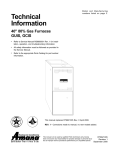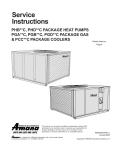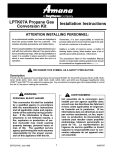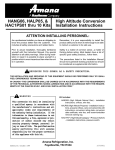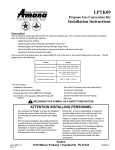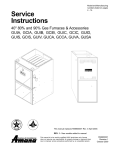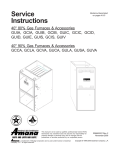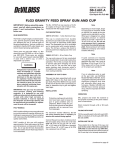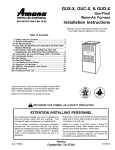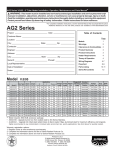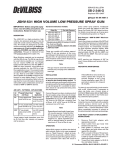Download Amana VR8205 Instruction manual
Transcript
® Heating ¡ Air Conditioning A higher standard of comfort HANG07, HALP09, and HAC1PS01-HAC1PS14 High Altitude Conversion Kit WARNING This conversion kit shall be installed by a qualified agency in accordance with the manufacturer’s instructions and all applicable codes and requirements of the authority having jurisdiction. If the information in these instructions is not followed exactly, a fire, explosion or production of carbon monoxide may result causing property damage, personal injury or loss of life. The qualified service agency performing this work assumes responsibility for the proper conversion of this appliance with this kit. Installation Instructions Affix this manual, Specification Sheet and Users Information Manual adjacent to the furnace. KIT INCLUDES: HANG07 (High Altitude Natural Gas) - installation instructions, orifices, wire ties. HALP09 (High Altitude Propane Gas) - installation instructions, propane orifices, valve conversion kits with instructions, conversion rating plate, conversion date certificate, wire ties, and screen/turbulator removal warning tag. HAC1PS** (High Altitude Category I Pressure Switch) installation instructions, pressure switch. IMPORTANT NOTE: These kits are approved for use on Amana furnace models listed on the following page only. All of the models listed have an Annual Fuel Utilization Efficiency (AFUE) of 80%. THE INSTALLATION AND SERVICING OF THIS EQUIPMENT SHOULD BE PERFORMED ONLY BY QUALIFIED, EXPERIENCED TECHNICIANS. THIS KIT IS NOT INTENDED FOR USE IN CANADA. THE AMANA 80% FURNACES ARE CGA CERTIFIED TO 4500 FEET ONLY. ! RECOGNIZE THIS SYMBOL AS A SAFETY PRECAUTION. ATTENTION INSTALLING PERSONNEL As a professional installer you have an obligation to know the product better than the customer. This includes all safety precautions and related items. Prior to actual installation, thoroughly familiarize yourself with this Instruction Manual. Pay special attention to all safety warnings. Often during installation or repair it is possible to place yourself in a position which is more hazardous than when the unit is in operation. safely and to know it well enough to be able to instruct a customer in its safe use. Safety is a matter of common sense...a matter of thinking before acting. Most dealers have a list of specific good safety practices...follow them. The precautions listed in this Installation Manual should not supersede existing practices but should be considered as supplemental information. Remember, it is your responsibility to install the product July 1998 (2) Amana Fayetteville, TN 37334 10759906 I. Description proper amount of air into the burner. This can cause incomplete combustion of the gas, flashback, and/or possible yellow tipping. HANG07, HALP09, and HAC1PS01-14 conversion kits are required when installing the following units above their maximum rated altitudes: In addition to using smaller orifices to reduce the fuel input, a different pressure switch must be used at altitudes above the rated altitudes shown in table 1 because of the reduced air density. This is required regardless of the heat content of the fuel used. Amana Air Command 80 SSE Amana Air Command SSE II Amana Air Command SSEIIQ Amana SV furnaces Amana Packaged Gas/Electric Units: PGA/B/D**C II. Pressure Switch Installation Increases in altitude reduce atmospheric pressure and oxygen content. These reductions effect operating pressures as well as the amount of oxygen which is available for combustion. At higher altitudes, the induced draft blower moves the appropriate CFM with less oxygen and produces a lower pressure at the pressure tap. To maintain a proper air to fuel ratio and to provide proper safeguards under adverse conditions (i.e., blocked flue, blocked drains, etc.), changes must be made to the unit orifice and pressure switches. See Table 1 to see what units are affected at what altitude. CAUTION To avoid the risk of fire, property damage, or personal injury, shut off gas supply first, then disconnect the electrical supply before proceeding with conversion. 1. Shut off gas and disconnect electrical supply. 2. Remove pressure switch(es) by removing mounting screws, disconnecting rubber hose and disconnecting wiring (see Figure 1 for typical location). NOTE: Failure to follow these procedures can lead to inefficient and/or incomplete combustion, exposure to lifethreatening CO and CO2 levels, and possibly premature heat exchanger failure. Furnace Model GUIA GUIB GCIA GCIB GUIC GCIC GUID PGA/B/D**C GUIS GUIV GCIS CAUTION To avoid the risk of fire, property damage, or personal injury, if disconnecting wires on the pressure switch, make certain to reconnect the wires in the same location. Rated Altitude Without Change Pressure Switch Up to 7500 Feet Up to 6000 Feet Up to 3000 Feet Table 1 Figure 1 Pressure Switch (Typical Location) The orifices in the high altitude kits have been selected as a result of testing with the American Gas Association. They will provide appropriate derating at altitudes above rated altitudes shown in table 1. The selection is based on nonderated gas (about 1000 BTU/ft 3 for natural gas, and 2500 BTU/ft 3 for propane gas). If your gas supply has been derated for the altitude, contact your gas supplier for orifice sizing. 3. Install the required high altitude pressure switch(es). For single-stage furnaces, see table 2. For two-stage furnaces (GUIS, GCIS, GUIV), see table 3. Do not derate by adjusting the manifold pressure to a lower pressure setting than what is specified on the furnace nameplate. With a lower density of air and a lower manifold pressure at the burner orifice, the orifice will not aspirate the 2 HAC1PS GUI(A/B)045(A/B) 7501 - 9500 ft 9501 - 11000 ft GUI(A/B)045(CA/CX) 7501 - 9500 ft 9501 - 11000 ft Nat. Gas Derates (See Sec. V) 01 34±4% 42±4% X X 03 04 05 06 07 08 09 10 11 12 34±4% 42±4% GUI(A/B)070(A/B/CA/CX) 7501 - 9500 ft 9501 - 11000 ft 33±4% 41±4% GUI(A/B)090(A/B/CA/CX) 7501 - 9500 ft 9501 - 11000 ft 31±4% 38±4% GUI(A/B)115(A/B/CA/CX) 7501 - 9500 ft 9501 - 11000 ft 27±4% 34±4% GUI(A/B)140(A/B/CA/CX) 7501 - 9500 ft 9501 - 11000 ft 25±3% 30±3% GCI(A/B)045(A) 7501 - 9500 ft 9501 - 11000 ft GCI(A/B)070(A) 7501 - 9500 ft 9501 - 11000 ft GCI(A/B)090(A) 7501 - 9500 ft 9501 - 11000 ft GCI(A/B)115(A) 7501 - 9500 ft 9501 - 11000 ft GCI(A/B)140(A) 7501 - 9500 ft 9501 - 11000 ft GCI(A/B)045(CA/CX) 7501 - 9500 ft 9501 - 11000 ft GCI(A/B)070(CA/CX) 7501 - 9500 ft 9501 - 11000 ft GCI(A/B)090(CA/CX) 7501 - 9500 ft 9501 - 11000 ft GCI(A/B)115(CA/CX) 7500 - 9500 ft 9500 - 11000 ft GCI(A/B)140(CA/CX) 7501 - 9500 ft 9501 - 11000 ft GUIC, GCIC, GUID 6001 - 8500 ft 8501 - 11000 ft PRESSURE SWITCH SETTING " WC 02 14 X X X X X X X X 34±4% 42±4% X X X X 33±4% 41±4% X X 31±4% 38±4% X X 27±4% 34±4% X 25±3% 30±3% X X X 34±4% 42±4% 33±4% 41±4% 13 X X X X 31±4% 38±4% X 27±4% 34±4% X X 25±3% 30±3% X X X 33±2.5% 38±3% X X -1.42 -1.30 -1.20 -1.14 -1.10 -1.05 -1.00 -0.95 -0.89 -0.85 -0.50 -0.41 -1.66 -1.57 Table 2 Pressure Switch Kits (Category I Venting Only) 3 GUIS, GUIV, GCIS High Altitude Charts GUI(S,V)070 GUI(S,V)090 GUI(S,V)115 GUI(S,V)140 GCIS070 GCIS090 Low Pressure Switch "WC High Pressure Switch "WC Natural Gas Orifices (DMS) HATS01 X For 3,001 feet to 7,000 feet HATS02 HATS03 HATS04 HATS05 X HATS06 X X X For 7,001 to 8,500 feet HATS07 HATS08 HATS09 X X -0.37 -0.66 #44 -0.37 -0.6 #44 -0.37 -0.55 #44 X -0.32 -0.55 #44 X X -0.27 -0.46 #44 -0.32 -0.55 #45 -0.32 -0.46 #45 -0.27 -0.46 #45 X X -0.23 -0.37 #45 Table 3 4. Reconnect the hose and wires. Reconnect wiring according to the wiring diagram located inside the blower compartment access panel. 5. Proceed with orifice installation. 2. Replace natural gas orifices (Figure 3 & 4) with the correct orifice kit depending on propane or natural gas usage and the altitude at the installation site. Refer to Tables 3, 4, and 5 for the appropriate kit required. Orifices III. Orifice Installation CAUTION To avoid the risk of fire, property damage, or personal injury, shut off gas supply first, then disconnect the electrical supply before proceeding with conversion. Figure 3 Replacing Gas Orifices 1. Remove the gas manifold by removing the burner box front cover (not required on all models), cutting the wire ties, disconnecting the gas valve low voltage wires, and removing the four manifold mounting screws (see Figure 2). Burner Box Figure 4 Orifices Front Cover Manifold Figure 2 Gas Manifold Removal 4 Furnace Model GUIA GUIB GCIA GCIB GUIC GCIC GUID PGA/B/D**C Kit Number Altitude (Feet) Orifice HANG07 7501 - 11000 #45 Orifice HANG07 6001 - 11000 Figure 5 Package Unit Orifice #45 CAUTION NOTE: Units Installed in Canada are certified to 4500 feet only, therefore these kits are not applicable in Canada. To prevent premature heat exchanger failure, follow the instructions below to remove all metal inserts from the heat exchanger tubes during conversions to propane gas. Table 4 Natural Gas Orifice Kits* * This table assumes non-derated natural gas (about 1000 BTU/ft3). If your gas supply has been derated for the altitude, contact your gas supplier for orifice sizing. Furnace Model Kit Number Altitude (Feet) Orifice GUIA GUIB GCIA GCIB HALP09 7501 - 11000 #56 HALP09 6001 - 11000 #56 HALP09 7001 - 8500 #56 GUIC GCIC GUID PGA/B/D**C GUIS GUIV GCIS 4. If converting to propane gas, remove metal screen inserts, where present, from the entrance of the heat exchanger tubes. (See Figure 6 and follow the a,b,c directions) NOTE: Some models do not have metal screen inserts. NOTE: Units Installed in Canada are certified to 4500 feet only, therefore these kits are not applicable in Canada. Table 5 Propane Gas Orifice Kits Figure 6 Removal of Metal Screen Inserts 3. Tighten orifices with a box-end wrench. Do not use a socket wrench as it could damage the orifices. Do not overtighten. Do not cross thread. PGA**C, PGB**C and PGD**C models only: Remove pilot tube from gas valve. Remove the screws holding the pilot assembly to the burner tray. Remove the assembly. Remove the pilot orifice as shown in Figure 5. Replace the pilot orifice with the orifice provided with the kit, and reassemble in reverse order. a. Remove entire burner box assembly, including burners, from the partition panel as one unit. b. Hold assembly and remove the screen retention plate and tube inserts from each section of the heat exchanger. c. Reinstall the retention plate and entire burner box assembly. NOTE: To prevent unsatisfactory unit operation, the proper gas conversion kit must be used for each gas valve. Use the White-Rodgers kit only with the White-Rodgers gas valve, the Honeywell Spring kit only with the Honeywell gas valve and the Robertshaw kit only with the Robershaw gas valve. THE SPRING KITS ARE NOT INTERCHANGEABLE. 5 CAUTION NOTE: Two stage furnaces do not require a spring kit. Discard all spring kits. To prevent unsatisfactory furnace operation, the proper gas conversion kit must be used for each valve. Use the WhiteRodgers spring kit only with the WhiteRodgers gas valve, Honeywell spring kit only with the Honeywell gas valve and Robertshaw spring kit only with the Robershaw gas valve. THE SPRING KITS ARE NOT INTERCHANGEABLE. 5. Reinstall the gas manifold and reconnect the gas valve low voltage wiring. Install new wire ties making sure that wires do not droop between orifices and burners. 6. If converting to propane gas, see PROPANE GAS CONVERSION section for additional instructions. If remaining on natural gas, skip to OPERATIONAL CHECK. IV. Propane Gas Conversion IMPORTANT: Propane gas is heavier than air and does not vent upward as with natural gas fuels. WARNING PERSONAL INJURY HAZARD If your propane gas furnace is installed in a basement, an excavated area or a confined space, we strongly recommend that you contact your propane supplier about installing a warning device that would alert you to a gas leak. Propane gas is heavier than air and any leaking gas can settle in any low areas or confined spaces. Propane gas odorant may fade, making the gas undetectable except with a warning device. An undetected gas leak would create a danger of explosion or fire. If you suspect the presence of gas, follow the instructions on the cover of the furnace installation manual. Failure to do so could result in SERIOUS PERSONAL INJURY OR DEATH. CAUTION To prevent premature heat exchanger failure, follow the instructions below to remove all metal inserts from the heat exchanger tubes during propane gas conversions. 1. IMPORTANT: Remove the metal inserts from the entrance of all heat exchanger tubes, as shown in Figure 6. This should be done as part of the “ORIFICE INSTALLATION” procedure. 2. Replace the gas valve regulator spring with one of the new springs included in this propane gas conversion kit. If the unit is equipped with a White-Rodgers 36E gas valve, (Figures 7 & 8), use Spring Kit #92-0659. If the unit is equipped with a Honeywell VR8205, SV9500, or SV9501 gas valve, (Figure 9, 12, &13), use Spring Kit #393691. If the unit is equipped with a Robertshaw 7222 gas valve, (Figure 10), use Spring Kit #54300. In each case, change the regulator spring per instructions included with that particular regulator spring. Discard unused spring kits. WARNING NOTE: White-Rodgers 36E96 (Figure 11), gas valves, do not require a spring kit. Discard all spring kits. PERSONAL INJURY HAZARD Iron oxide (rust) can reduce the level of odorant in propane gas. A gas detecting device is the only reliable method to detect a propane gas leak. Contact your propane supplier about installing a gas detecting warning device to alert you in the event that a gas leak should develop. Failure to detect a propane gas leak could result in an EXPLOSION or FIRE which could cause SERIOUS PERSONAL INJURY OR DEATH. 3. Attach the label (found in the spring kit) to the gas valve, indicating propane conversion. 4. Attach conversion data plate, with correct input rating, adjacent to the unit rating plate. 5. Post “conversion date certificate” adjacent to the furnace. 6 Gas Valve On/Off Selector Switch INLET High Manifold Regulator Adjustment Screw (Under Cap) O F F M 1 P 3 C 2 PM C HI OUTLET Inlet ON Outlet OFF ON Inlet Pressure Tap (Side of Valve) Pressure Regulator Adjustment (Under Cap Screw) Outlet (Manifold) Pressure Tap (Side of Valve) Inlet Pressure Tap Low Manifold (Side) Regulator Adjustment Gas Valve Screw (Under Cap) Control Knob Figure 7 White-Rodgers 36E22 Gas Valve Figure 11 White-Rodgers 36E96 Gas Valve Gas Valve On/Off Control Knob Pressure Regulator Adjustment (Under Cap Screws) INLET Outlet (Manifold) Pressure Tap (Side) Mates With Honeywell Q3450* Pilot Harness OUTLET 1/2PSI Inlet Pressure Tap Outlet (Manifold) Pressure Tap INLET OFF Figure 8 White-Rodgers 36E36 Gas Valve Pressure Regulator Adjustment (Under Cap Screw) Gas Control/Valve Knob Outlet Pressure Tap Figure 12 Honeywell SV9500 Gas Valve Outlet (Manifold) Pressure Tap Mates With HONEYWELL Q3450* Pilot Harness Pressure Regulator Adjustment (Under Cap Screw) Honeywell INLET OUTLET ON Pressure Regulator Adjustment (Under Cap Screw) IN Inlet Pressure Tap (Side of Valve) OUTLET ON 2 Mates With Socket Housing Control Module Gas Valve On/Off Control Lever In ON Position INLET Outlet Pressure Tap 1/8 N.P.T., Plugged (Steel) Figure 13 Honeywell SV9501 Gas Valve Outlet (Manifold) Pressure Tap (Side of Valve) OUTLET Inlet Pressure Tap (Side of Valve) OUTLET CONTROL Figure 9 Honeywell VR8205 Gas Valve ON OFF IN INLET Gas Valve On/Off Control Knob IGNITOR PSI OFF Inlet Pressure Tap Pressure Regulator Adjustment (Under Cap Screw) Figure 10 Robertshaw Model 7222 7 5. Check The Manifold Pressure On single stage units, set the manifold pressure to 10.0” W.C. (water column). For direct vent (GUD, GCD) furnaces, see “Setting GUD and GCD Manifold Pressure” before setting pressure (Figure 12). On two stage units, adjust the high stage manifold pressure to 10.0” W.C. and the low stage manifold pressure to 6.0” W.C. (Figure 11). The White-Rodgers 36E96 gas valve requires a 3/32” allen wrench to adjust the manifold pressures. A tapped opening is provided in the gas valve (Figures 7 through 13) to facilitate measurement of the manifold pressure. A "U Tube” manometer having a scale range from 0 to 12 inches of water column should be used for this measurement (Figure 14). The manifold pressure must be measured with the burners operating, and with the burner box cover (cover not used on all models) in place. Single Stage Furnaces To adjust the pressure regulator, remove the adjustment screw cover on the gas valve. Turn out (counterclockwise) to decrease pressure, turn in (clockwise) to increase pressure. (“Manifold Pressure Adjustment” in Figure 7 through 13). Only small variations in gas flow should be made by means of the pressure regulator adjustment. For natural gas, the manifold pressure must be between 3.2 and 3.8 inches water column (3.5” nominal). For propane gas, the manifold pressure must be between 9.7 and 10.3 inches water column (10.0” nominal). Any major changes in flow must be made by changing the size of the burner orifices. Two Stage Furnaces To adjust the pressure regulator, remove both high and low adjustment screws on the gas valve (Figure 11). Using a 3/32” allen wrench turn out (counterclockwise) to decrease pressure, turn in (clockwise) to increase pressure. a. Adjust the low stage regulator to increase low stage output so furnace will light and carryover. b. Adjust the high stage regulator to required manifold pressure setting. c. Reinstall high stage cap screw. d. Recheck manifold pressure setting with cap on. e. Adjust low stage regulator to required manifold pressure setting. f. Reinstall low stage cap screw. g. Make sure furnace operates at the proper manifold pressure at both high and low stage outputs. For propane gas, the manifold pressure must be between 9.7 and 10.3 inches water column (10.0 nominal). The low stage manifold pressure must be between 5.7 and 6.3 inches water column (6.0 nominal). V. Operational Check 1. Start the furnace using the procedures in the section, “Operating Your Furnace” in the installation instructions. In addition, perform the following checks and adjustments. 2. The position of the ignitor, relative to the burner, is not affected by this conversion procedure but the ignitor should be visually inspected for any damage at this point. 3. Check For Leaks - Leak check the orifice threads by using a soap solution. Reinstall the burner box cover. WARNING To avoid the risk of fire or explosion, do not use a flame to check for leaks. 4. Check Gas Input And Pressures Check inlet gas pressure. With the power and gas off, connect a water manometer or adequate gauge to the “inlet pressure tap” of the gas valve. With the power and gas on, put the furnace into heating cycle and turn on all other gas consuming appliances. For natural gas, the inlet gas pressure should be between 5.0 and 10.0 inches of water. For propane gas the inlet gas pressure should be between 11.0 and 13.0 inches of water. Gas Line Gas Shutoff Valve Gas Line To Furnace Open To Atmosphere Drip Leg Cap With Fitting Manometer Hose Manometer Figure 14 Manometer 8 Natural Gas Input (BTU/hr) at Altitude for GUIC, GUID, GCIC, PGA**C, PGB**C, PGD**C Heating Input (BTU/hr) 46,000 69,000 92,000 115,000 138,000 6,001 feet 6,500 feet 7,000 feet 7,500 feet 8,000 feet 8,500 feet 9,000 feet 9,500 feet 10,000 10,500 11,000 feet feet feet 31,970 47,955 63,940 79,925 95,910 31,510 47,265 63,020 78,775 94,530 31,050 46,575 62,100 77,625 93,150 30,590 45,885 61,180 76,475 91,770 31,130 45,195 60,260 75,325 90,390 29,670 44,505 59,340 74,175 89,010 29,348 44,022 58,686 73,370 88,044 28,796 43,194 57,592 71,990 86,388 28,244 42,366 56,488 70,610 84,732 27,692 41,538 55,384 69,230 83,076 27,140 40,710 54,280 67,850 81,420 Table 6 Natural Gas Firing Rates Low Stage Inputs and High Stage Inputs (BTU/hr) at Altitude Stage Low High 3,001 feet 47,040 64,170 3,500 feet 46,080 62,790 4,000 feet 45,120 61,410 4,500 feet 44,160 60,030 5,000 feet 43,920 59,616 5,500 feet 43,680 59,202 6,000 feet 43,440 58,788 6,500 feet 43,200 58,374 7,000 feet 42,990 57,940 7,001 feet 39,121 52,725 7,500 8,000 feet 8,500 feet feet 38,621 37,401 36,542 51,567 50,408 49,249 GUI(S,V)090 Low High 62,720 85,560 61,440 83,720 60,160 81,880 58,880 80,040 58,560 79,488 58,240 78,936 57,920 78,384 57,600 77,832 57,320 77,253 52,161 70,301 51,015 68,755 49,868 67,210 48,722 65,665 GUI(S,V)115 Low High 78,400 76,800 75,200 73,600 72,200 106,950 104,650 102,350 100,050 99,360 72,800 98,670 72,400 97,980 72,000 97,290 71,650 96,567 65,202 87,876 63,769 85,944 62,336 84,013 60,903 82,082 GUI(S,V)140 Low High 94,080 92,160 90,240 88,320 87,840 87,360 86,880 86,400 85,980 78,242 76,522 128,340 125,580 122,820 120,060 119,232 118,404 117,576 116,748 115,880 105,451 103,133 74,803 100,816 73,083 98,498 GCIS070 Low High 47,040 64,170 46,080 62,790 45,120 61,410 44,160 60,030 43,920 59,616 43,680 59,202 43,440 58,788 43,200 58,374 42,990 57,940 39,121 52,725 38,261 51,567 37,401 50,408 36,542 49,249 GCIS090 Low High 62,720 85,560 61,440 83,720 60,160 81,880 58,880 80,040 58,560 79,488 58,240 78,936 57,920 78,384 57,600 77,832 57,320 77,253 52,161 70,300 51,015 68,755 49,868 67,210 48,722 65,665 Model GUI(S,V)070 Table 7 6. Check The Gas Input - Natural Gas To measure the gas input using the gas meter, proceed as follows: a. Turn off gas supply to all other appliances except the furnace. b. With the furnace operating, time the smallest dial on the meter for one complete revolution. If this is a 2 cubic foot dial, divide the seconds by 2; if it is a 1 cubic foot dial, use the seconds as is. This gives the seconds per cubic foot of gas being delivered to the furnace. c. INPUT = (GAS HTG VALUE) x (3600) ÷ (SEC. PER CUBIC FOOT) Example: Natural gas with a heating value of 1000 BTU per cubic foot and 34 seconds per cubic foot as determined by Step 2, then: Input = 1000 x 3600 ÷ 34 = 106,000 BTU per Hour NOTE: BTU content of the gas should be obtained from the gas supplier. (3600 is a conversion factor between seconds and hours). This measured input must agree with the derates for the furnace model, input, and installation altitude as indicated in the appropriate tabel (Table 2, Table 6, or Table 7). See Derating Examples 1-4 for use of tables. d. Relight all other appliances turned off in Step 6a. Be sure all pilot burners are operating. Derating Example 1: GUIA115A40 at 8500 ft. Sea level input = 115,000 BTU/Hr. From Table 2: Derate at 8500 ft. = 27±4% Since we are at the mid point of the elevation range, we use the mid point of the derate; 27%. New Input = 115000 x (1 - .27) = 83950 BTU/hr Derating Example 2: GUIC045DA30 at 7500 ft. Sea level input = 46,000 BTU/hr From Table 6 rate at 7500 ft. = 30,590 BTU/hr Derating Example 3: GUIS115CA50 at 4500 ft. Sea level input = 80,000 BTU/hr (Low Stage) 115,000 BTU/hr (High Stage) From Table 7 rates at 4500 ft.= 73,600 BTU/hr (Low Stage) 100,050 BTU/hr (High Stage) Derating Example 4: PGB36C0902D at 6500 ft. Sea level input = 92,000 BTU/hr (High Stage) From Table 6 rate at 6500 ft.= 63,020 BTU/hr 9 7. Check The Gas Input - Propane Gas Verify the gas input rate by checking that the appropriate orifices have been installed and the manifold pressure has been set as stated in these instructions. 8. Check Burner Flames Check burner flames through the view port in the burner box. Flames should be stable, soft and blue, (dust may cause orange tips but they must not be yellow). They should extend directly outward from the burners without curling, floating, or lifting off. 9. Check the normal operating sequence of the ignition system to insure burners light properly. 10. Check Temperature Rise NOTE: The relationship between external static pressure and temperature rise will be different than is shown in the Installation Instructions, while the relationship between CFM and temperature rise will be about the same. Temperature rise must still be within the limits on the nameplate. Check the temperature rise through the unit by placing thermometers in supply and return air registers as close to the furnace as possible. Thermometers must not be able to “see” the furnace’s heat exchangers, or false readings could be obtained. • All registers must be open, all duct dampers must be in their final (fully or partially open) position, and the unit operated for 15 minutes before taking readings. • The temperature rise for each heating speed must be within the range specified on the rating plate or Specification Sheet. NOTE: Air temperature rise is the temperature difference between supply and return air. With a properly designed system, the proper amount of temperature rise will normally be obtained when the unit is operated at rated input with the “as shipped” blower speed. If the correct amount of temperature rise is not obtained, it may be necessary to change the blower speed. A faster blower speed will reduce the temperature rise. A slower blower speed will increase the temperature rise. If it is necessary to adjust the blower speed, consult the furnace installation manual for details. 11. For propane gas conversions, attach conversion data plate, with correct input rating, adjacent to the unit rating plate and post “conversion date certificate” adjacent to the furnace. VI. Complete The Installation See the furnace installation manual for all installation details which were not covered in this booklet. 10










